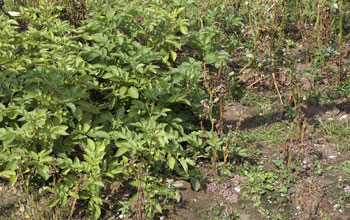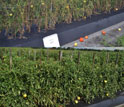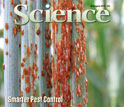Plant immune system research ready for application, say researchers.-
 Credit and Larger Version |
August 15, 2013
In the battle between
diseases and plants--constant, changing and centuries old--scientists
and farmers usually arm themselves through classical breeding, crossing
varieties in the hopes of eventually reaching disease resistance. With
advances in DNA sequencing and genetics, however, they may soon have a
more sophisticated weapon: disease-resistant seeds.
Basic
research on the genetic gears of plant immune systems has advanced so
much that scientists can now begin applying that knowledge, building
healthier plants to decrease dependence on pesticides, water overuse and
help agriculture in developing countries, according to a paper in this
week's edition of the journal Science.
"I think the
backdrop is simple: We need to feed a lot of people, and we need to do
it in a sustainable way," said Jeff Dangl, one of the paper's authors.
He is a Howard Hughes Medical Institute investigator and biology
professor at the University of North Carolina. "We need to feed them in a
way that we use no more land than we use now. We need to do it more
efficiently, and we need to do it in the face of ever-evolving
pathogens."
The paper was also authored by Brian Staskawicz,
plant and microbial biology professor at the University of California,
Berkeley, and Diana Horvath, director of the Two Blades Foundation, a
Chicago-area nonprofit promoting plant disease resistance research and
application. NSF funds have helped fuel the research of all three.
The
paper synthesizes two decades of research on plant immune systems,
looking at "where technology has been applied, and what the future can
be," said Staskawicz.
For more than a century, disease resistance
in plants has been achieved through traditional breeding, a process
that requires the "patience of Job," Dangl said. "Imagine waiting till
you get to your grandchildren to see how your offspring turn out."
Disease-causing
microbes multiply much, much faster. Modern agriculture--predominately
single crops grown over many acres instead of the diversity hodgepodge
seen in nature--also favors pathogens, microbial agents that cause
disease.
Globally, about 15 percent of crop harvests are lost
each year due to disease, but destruction varies greatly from crop to
crop. Cassava blight, which attacks a staple food source in many
developing countries, can destroy 20 to 100 percent of crops. Most loss
occurs late in a crop's life, gallons and gallons and gallons of water
in. "Plant diseases are a huge waste of water," Dangl said.
To
combat pathogens, farmers rely on disease-resistant plant
varieties--cultivated by careful, slow breeding--and pesticides. Both
are far from foolproof. Pathogens evolve to outwit breeding and
pesticides often carry harmful environmental side effects. Some farmers,
like those in developing countries, also can't afford them. Creating
disease resistant seeds, requiring little-to-no pesticides and no
unfamiliar agricultural techniques, is "a simple and effective way to
help farmers in developing countries," Horvath said.
Classical
breeding has given plant researchers a wealth of genetic material,
developed over generations, with which to breed disease resistant
varieties. Combined with leaps and bounds in genetics research and
quicker, cheaper DNA sequencing, scientists have learned how to build
stronger plant varieties. They have pinpointed special receptors, housed
both inside and outside plant cells, which scan for infection;
launching the attack when a pathogen is found. They've identified
disease-resistant genes housed in the molecular architecture of
different plants. These genes can confer resistance to dangers such as
wheat rust, powdery mildew and bacterial spot disease.
"We now
know enough about the key molecules in the plant immune system that we
can actually start to deploy what we've learned," said Dangl. This
includes genetic editing--removing disease-prone genes--or mining
disease-resistance genes from various plants and adding them into other
crops. Combining a few disease-resistance genes would bolster plant
immunity to multiple diseases, similar to the chemical cocktail
developed to fight AIDS.
The ultimate objective is to build
"predictive, highly refined molecular plant breeding that includes
disease resistance," Dangl said. It's essentially an updated version of
classical breeding, injecting genetic know-how into seed creation using
disease-resistance genes from plants people eat every day: wheat, rice,
pepper, tomato and others.
This has already been successful.
Disease resistance genes bred into papaya helped save Hawaii's papaya
industry from a ringspot virus in the mid-90s. Staskawicz and Horvath
also worked to develop tomato plants resistant to bacterial pathogens.
In Florida field tests, the modified varieties have higher yields and
don't require harmful copper pesticides.
Still, researchers have
much to learn. How all these disease resistance genes function, on a
molecular basis, is to be discovered. Staskawicz compares it to
watching TV. You know if you press a certain button, the TV comes on,
without understanding any mechanics behind the screen. "You can still
use the gene without knowing exactly how it works," he said. Pathogens
will also continue evolving, slowly subverting genetic disease
resistance, engineered or not. "It's a constantly evolving process,"
Staskawicz said.
There are no simple solutions, said Michael
Mishkind, a program director in NSF's Biological Sciences Directorate.
Yet our current level of understanding of disease resistance mechanisms
"speaks eloquently to the importance of basic research. Years of
fundamental study of the plant immune system have added a powerful set
of tools, helping us keep ahead of the pathogens that threaten our food
supply."
-NSF-
Media Contacts
Jessica Arriens, NSF (703) 292-2243
Related WebsitesTwo Blades Foundation:
http://2blades.org/
Staskawicz Laboratory, UC-Berkeley:
Staskawicz Laboratory, UC-Berkeley:
http://www.staskawiczlab.org/
Jeff Dangl, Howard Hughes Medical Institute:
Jeff Dangl, Howard Hughes Medical Institute:
The National Science Foundation (NSF) is an independent federal
agency that supports fundamental research and education across all
fields of science and engineering. In fiscal year (FY) 2012, its budget
was $7.0 billion. NSF funds reach all 50 states through grants to nearly
2,000 colleges, universities and other institutions. Each year, NSF
receives about 50,000 competitive requests for funding, and makes about
11,500 new funding awards. NSF also awards about $593 million in
professional and service contracts yearly.
Useful NSF Web Sites:
NSF Home Page:
NSF Home Page:
http://www.nsf.gov
NSF News:
NSF News:
http://www.nsf.gov/news/
For the News Media:
For the News Media:
http://www.nsf.gov/news/newsroom.jsp
Science and Engineering Statistics:
Science and Engineering Statistics:
http://www.nsf.gov/statistics/
Awards Searches:
Awards Searches:

The effects of bacterial leaf spot disease on regular tomatoes (on top) and genetically altered ones
Credit and Larger Version

The researchers' work is described in the Aug. 16, 2013, issue of the journal Science.
Credit and Larger Version
The National Science Foundation (NSF).
Guillermo Gonzalo Sánchez Achutegui
ayabaca@hotmail.com
ayabaca@gmail.com
ayabaca@yahoo.com
No hay comentarios:
Publicar un comentario